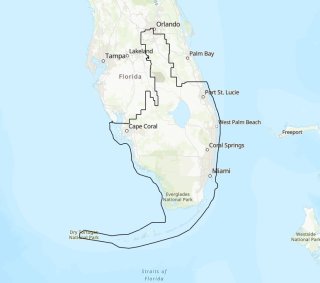South Florida Program (SFP): Overview
Learn more about the South Florida Program
The Environmental Protection Agency South Florida Program (SFP) is a geographic program designed to assist local communities with water quality improvement, climate resilience, and environmental education. The SFP is committed to protecting and restoring waters within Florida Keys, Biscayne Bay, Florida Bay, Caloosahatchee Estuary, Indian River Lagoon, the Everglades and the entire SFP area. Since 2005, the SFP has awarded grants to fund projects important to the immediate and emerging needs and threats to south Florida.
Geography

The EPA’s South Florida Program includes a large portion of Florida beginning south of Orlando, running down the center of the state about 75 miles and then reaching to each coast including the southern part of the Indian River Lagoon on the east and Charlotte Harbor on the west, Lake Okeechobee, the Everglades, and through the Florida Keys to the Dry Tortugas National Park. The entire area, including land and open water, is over 21,000 square miles and is intimately linked to water. The SFP boundary matches the South Florida Water Management District boundary and includes Broward, Collier, Glades, Hendry, Lee, Martin, Miami-Dade, Monroe, Palm Beach and St. Lucie counties, as well as portions of Charlotte, Highlands, Okeechobee, Orange, Osceola and Polk counties.
Focus Areas
The South Florida Program is currently developing a management plan that incorporates feedback from citizens, educational institutions, local governments, and state and federal partners. This management plan will help direct the SFP forward by ranking focus areas that have been identified by public feedback.
SFP grants support Special Studies and Research. Special Studies are projects that provide information specific to questions and concerns, inform policy, and provide understanding of south Florida aquatic ecosystems. Examples of eligible projects are listed on the South Florida Funded Projects page.
Florida Keys Water Quality Protection Program
In 1990, Congress formally recognized the uniqueness of the Florida Keys ecosystem with the signing of the Florida Keys National Marine Sanctuary and Protection Act. Acknowledging the critical role of clean, clear water in maintaining marine resources within the Sanctuary, the Act directed the U.S. Environmental Protection Agency, the State of Florida and the National Oceanic and Atmospheric Administration to create a Water Quality Protection Program for the Sanctuary to be managed by a Steering Committee charged with establishing guidance, developing policy, and overseeing activities to restore and maintain Sanctuary resources. The SFP is an extension of the Florida Keys National Marine Sanctuary Water Quality Protection Program in which EPA and its partners are still active.
Population and Economy
Rapidly growing south Florida and its nearly 10 million residents are a multi-billion-dollar economy fueled by outdoor recreation, tourism (beaches, fishing, boating, and diving), commercial fishing, development, and farming that depend on clean drinking water, rivers, lakes, estuaries, and oceans.
Equity and Inclusion
The EPA is committed to the principles of equity, inclusion, and environmental justice. Eighty-three percent of the south Florida population is within 15 miles of the ocean and 67% of the land area is open water or wetland. Since 2019, the SFP has funded projects in 18 watersheds. Fifteen of these watersheds have been identified as having disadvantaged communities within them.
To learn more about equity and inclusion at the EPA and discover where disadvantaged communities are located within the SFP, visit our SFP Equity and Inclusion page.
Climate Resilience
We live in a world where the climate is changing. The EPA includes climate resilience concepts into our South Florida Program to fulfill our mission to protect human health and the environment. Increasing climate resilience in south Florida is critical as natural disasters become more frequent and severe. The South Florida Program goal is to protect and restore our waterways, including coral reef, mangrove, and seagrasses to provide protection against these events.
To learn more about climate resilience at the EPA, visit our SFP Climate Resilience page.
For more information about the EPA’s South Florida Program, please contact: Elizabeth Smith at [email protected].
